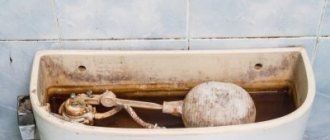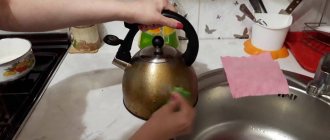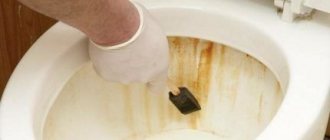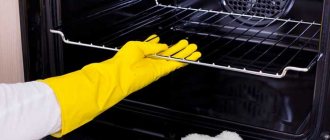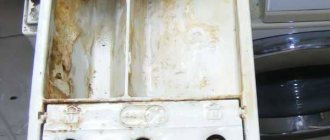To flush a standard 43–50 liter tank, you will need to prepare 2–3 liters of acetone. The procedure is performed as follows:
- Pour 1 liter of acetone into the dismantled gas tank.
- Close all drain holes and filler cap tightly.
- Shake the container well several times.
- Drain the liquid into a bucket.
- If a large amount of rust and dirt comes out along with acetone, then it is necessary to carry out the procedure one or two more times.
The properties of acetone allow you to efficiently remove rust from any metal surface.
Cleaning a motorcycle gas tank from rust: old-fashioned and modern methods
- Mix one glass of caustic soda in 30 liters of water.
- Fill the tank 90 percent with solution.
- Insert the conductor inside to the bottom without touching the walls. You can cut a wooden or plastic plug to fit the diameter of the neck and place this electrode in the middle.
- Connect the wire to the minus of the battery, and the cleaned area of the tank body to the plus.
- In 2-3 days, the internal space will be completely cleaned of traces of corrosion.
- After completing the process, you need to disconnect the battery and remove the electrode.
- Drain the liquid, rinse and dry the tank.
For metal to corrode, it needs contact with water and air. The tank is in constant contact with air, you only need to partially empty it, but it comes into contact with water in two cases:
Is it possible to flush the tank with gasoline?
Washing with gasoline (diesel fuel) is a mandatory step in all cleaning procedures. The fact is that after any, even the most thorough washing, a small amount of acid, acetone or washing powder inevitably remains in the gas tank. You cannot install such a tank on a car, because all this sediment will get into the fuel system, and from it into the engine.
Before pouring gasoline, it is recommended to dry the tank with a hairdryer - warm air will quickly dry all corners of the gas tank cavity. It will take a day or more for the container to dry on its own.
Therefore, after completing all cleaning procedures, it is necessary to carry out the last one - rinse the tank with fuel:
- Reinstall the tank.
- Connect all necessary lines.
- Fill the gas tank to the brim with gasoline.
- Close the lid.
- Start the engine and allow the fuel to circulate through the system.
- Add gasoline as it leaves the highways.
Protecting and treating the gas tank from the inside
I will not touch on methods for removing and cleaning it here. Everything is online. Starting from dancing with a gas tank in your hands, filled with nuts and diesel fuel, and ending with all kinds of drugs based on orthophosphoric acid, and even electrolysis cleaning.
The main question is how to protect the inside of the gas tank from subsequent rust formation? There is a lot of crap on the internet that says “pour gasoline and it will protect you.”
Why the hell didn’t he defend him before?! It's simple, and smart people know it. Water present in gasoline at gas stations. Condensate. All this floats below the gasoline, and is slowly eating away at the factory coating of the tank. If it exists at all. Is there zinc or tin?
The most incredible way to get my hair back!
This is just a DISASTER ! And after all, my hair did not start falling out in one day, but systematically - day after day I watched how the hair left my head: while combing, washing, even while sleeping. (read more…)
That is, having treated the gas tank from rye, we still doom it to a short life. Foci of corrosion treated with the same orthophosphorus, when water gets into the tank (and it will certainly be there!), will begin to corrode even more actively.
And tuuuut…. Here the network simply amazes with the scale of idiocy and incompetence. Just try typing in a search engine “how to treat the inside of a gas tank.” By a huge margin, bikers are in the lead here. From whom everything is adopted... crap.
Starting from car enamels (. inside. ), but a favorite nasty thing... EDP epoxy diluted (acetone, solvent 646) (for 200 rubles). And when the whining begins, “Damn, it fell off, dissolved, clogged,” there are commentators right there (bitch) (here I am! here I am!)—“you took the wrong epoxy.”
Yeah, fuck. Dilute the EDP with acetone and see what dries...
And for the most part, these containers are not aluminum, but are made of stainless steel. And made of iron. Ordinary. Look, there is an oil depot under my mountains. (Spakuha. The oil depot is not mine. If it were mine, damn if you saw me on this forum!) .
All the huge barrels there are steel. Actually, the oil depot gave me the idea.
And I called a friend who is almost the chief engineer there. — Do you paint the inside of the tanks? - Otherwise! - How many times per...? - And according to the regulations - once every five, ten, fifteen years. It depends on what, depending on what kind, depending on what condition.
Just like that. Moreover, they paint with compounds and enamels that do not need (there is no way to heat a 40,000 liter tank) temperature for polymerization or hardening.
I will give links to compositions and paints in general. And for applicability. And on properties.
Do you like guys with long hair?
Not really
In general, I will add to the topic in the following posts. They will get me what they use to paint the tanks at our oil depot. And the point won’t be in the can of paint. And in the whole situation according to its properties and nomenclature.
So, after treatment, I will definitely paint my tank (the main one, which is now filled with an orthophosphoric solution under the neck, and which is driven through the tank by the heater pump from the Gazelle).
All. Banana peels, slippers, fresh droppings are on the shelf on the right. You can throw it! Modified on June 9, 2022 by AlexeyK
How to remove rust from a motorcycle gas tank
Such care will help preserve gasoline filters and ensure uninterrupted operation of the entire fuel complex. The entry of small foreign particles into the engine threatens to cause it to fail.
Expert opinion
Ekaterina Korneva, expert in the field of care, cleanliness and beauty
I will help you understand all the intricacies.
During the cold season, experts periodically recommend removing moisture from the tank that could get there as condensation. When working with them, you should use protective equipment, since a drop that gets on the skin can cause severe burns. How to clean the inside of a gas tank without removing it If you have any questions, please contact me, I will be happy to answer!
How to clean the rust inside a gas tank video
- Fill the tank with hot water to about halfway. Hot water is needed to speed up the dissolution of rust.
- Add 2-3 liters of acid. It is important not to confuse the first two points, otherwise the mixture will instantly boil and the acid will get on the skin and face.
- Fill the tank with hot water to the brim.
- Seal the hole with an inert material that will not dissolve in the acid. Plastic lids will not work.
- Wait 2-3 hours, occasionally shaking the container.
- Drain the liquid.
- Rinse the tank with baking soda solution and then with hot water.
Not every car enthusiast wants to clean the gas tank from dirt and corrosion elements. Some people simply may not have enough time for this, so it is better to take steps to prevent these unpleasant phenomena from occurring:
We use acetone
To flush a standard 43–50 liter tank, you will need to prepare 2–3 liters of acetone. The procedure is performed as follows:
- Pour 1 liter of acetone into the dismantled gas tank.
- Close all drain holes and filler cap tightly.
- Shake the container well several times.
- Drain the liquid into a bucket.
- If a large amount of rust and dirt comes out along with acetone, then it is necessary to carry out the procedure one or two more times.
The properties of acetone allow you to efficiently remove rust from any metal surface.
How to flush the inside of the gas tank after removing it from the car
To properly clean the inside of the gas tank from deposits, you will need to first remove it from the car. On almost any car, this is not difficult to do, and the book on the technical operation of the car should describe in detail how this procedure is performed. There are several ways to flush the inside of a gas tank; we’ll look at the most popular ones below.
Cleaning the gas tank with soda
The cleansing powers of soda are legendary, and they're not based on nothing. Indeed, soda can remove rust, including that formed inside the gas tank.
The method of cleaning a gas tank with soda is quite expensive in terms of costs, but it is considered very effective and simple. Cleaning is performed as follows:
You need to take as much soda as the maximum liters of fuel that can fit in the gas tank. In this case, it is not necessary to use expensive soda, like Pepsi or Cola, since the effectiveness of this method depends on the presence of orthophosphoric acid in the water, which is also present in inexpensive drinks;
Don’t forget to rinse the gas tank thoroughly before adding gasoline so that there are no traces of the sweet drink left in it.
Electrolysis method of flushing a gas tank
An extremely effective way to clean a gas tank, which allows you not only to remove the rust that has formed, but also to restore the metal layer. It is based on the chemical reaction of electrolysis, which will result in the formation of hydrogen and gases, so carrying out the procedure in a closed room is extremely dangerous.
Electrolysis flushing of the gas tank is performed as follows:
Important: You cannot use an electrode made of stainless steel, otherwise the chemical process will result in the release of gas that is dangerous to humans.
When cleaning the gas tank is completed, drain the electrolysis, rinse and dry the tank, and only then fill in gasoline.
Cleaning the gas tank using phosphoric acid
A fairly simple and effective way to get rid of rust inside a gas tank. For cleaning, you will have to purchase orthophosphoric acid (if the acid is highly concentrated, it is better to dilute it) to obtain several liters of rust converter. With ama, cleaning is extremely simple:
When the work is completed, clean the gas tank with water and soda, then rinse everything again with plain water. It is important to completely remove any remaining acid from the gas tank. After washing, dry the tank and you can use it.
Cleaning the gas tank with nuts
How to rinse and clean a gas tank at home with your own hands: how to get rid of rust and dirt without removing the tank video » AvtoNovator
On the forums it is generally recommended that after all these procedures, fill the inside of the tank with epoxy. Think. but even without this, the result exceeded expectations. Thanks to chemists and citric acid!
Expert opinion
Ekaterina Korneva, expert in the field of care, cleanliness and beauty
I will help you understand all the intricacies.
Electrochemical cleaning should be carried out using thick rubber gloves and avoid getting the solution on exposed skin, since caustic is a strong alkali and causes burns to the body. Of course, a fuel filter is used for pre-cleaning, but small pieces of dirt will still pass through it. How to flush a gas tank and remove rust: simple methods For any questions, please contact me, I will be happy to answer!
Cleaning a motorcycle tank from internal rust
Maybe it will be useful for someone... In general, what can I tell you, friends. If you wash your motorcycle tank from rust, don’t repeat my mistakes. :))))) the tank is 25 years old, and apparently it stood empty and rusted for a long time.
Obviously, all previous actions (rust converter, abrasive, solvent) gave a very mediocre result. that is, the rust remains inside the tank. and not just a little, but quite a lot. Which gave me the idea to try a chemist I knew with a soldering iron. The chemist quickly gave up and said that there is such a cool thing -
How I found my ideal hair growth product
Hello dear! I want to share with you my solution to the sensitive problem of hair loss . The problems are very serious, at least for me. I would never have thought that this misfortune would touch me, especially at the age of 29 (read more...)
citric acid... which housewives add to all sorts of goodies. So, if you make a 3% solution of this very acid (hot solution), it will dissolve all the rust. It won’t peel off, won’t scrape off, but rather dissolve. Tank 24 liters. you need 720 grams of citric acid. but I waited and bought 620. The result was a slightly weaker acid. Considering that an 8 gram bag costs 7 rubles, then 620 grams came out fine. In chemical stores, a kilo costs 140 rubles, but for some reason they don’t sell it to private individuals.
We suggest you read: Washing and bleaching white socks in a washing machine or by hand
On the forums it is generally recommended that after all these procedures, fill the inside of the tank with epoxy. Think. but even without this, the result exceeded expectations. Thanks to chemists and citric acid!
Dirt, precipitation
- Treat the inside of the container with epoxy resin that does not dissolve in water. You just need to pour it into the tank and roll it over so that the protective coating covers all corners of the internal volume. After completion, the tank must be dried.
- You can choose an effective additive using the advice of friends or reviews on the Internet.
- Using your vehicle wisely and following simple operating rules will avoid the need to clean the fuel system. To do this, you need to refuel only at trusted gas stations, try to keep the tank as full as possible, especially before a long stop.
- During rain or fog, it is better to wait to add fuel.
- In winter, add alcohol or dehumidifier.
This way you can effectively remove rust from the gas tank. If there is advanced corrosion, holes and cracks may form during the dry cleaning process. In such cases, electrolysis would be more appropriate.
Which methods are not suitable?
It is not recommended to use mechanical cleaning
to remove corrosion .
The use of abrasives or hard metal objects may simply cause a hole to appear in the tank. For the same reason, high concentration acids should not be used to remove metal oxide.
Do not throw nuts, washers or bolts into the container . When shaking, the intact metal will be knocked off along with the rust, causing the tank to quickly become unusable.
How to flush the inside of the gas tank after removing it from the car
To properly clean the inside of the gas tank from deposits, you will need to first remove it from the car. On almost any car, this is not difficult to do, and the book on the technical operation of the car should describe in detail how this procedure is performed. There are several ways to flush the inside of a gas tank; we’ll look at the most popular ones below.
Cleaning the gas tank with soda
The cleansing powers of soda are legendary, and they're not based on nothing. Indeed, soda can remove rust, including that formed inside the gas tank.
The method of cleaning a gas tank with soda is quite expensive in terms of costs, but it is considered very effective and simple. Cleaning is performed as follows:
Don’t forget to rinse the gas tank thoroughly before adding gasoline so that there are no traces of the sweet drink left in it.
Electrolysis method of flushing a gas tank
An extremely effective way to clean a gas tank, which allows you not only to remove the rust that has formed, but also to restore the metal layer. It is based on the chemical reaction of electrolysis, which will result in the formation of hydrogen and gases, so carrying out the procedure in a closed room is extremely dangerous.
Electrolysis flushing of the gas tank is performed as follows:
When cleaning the gas tank is completed, drain the electrolysis, rinse and dry the tank, and only then fill in gasoline.
Cleaning the gas tank using phosphoric acid
A fairly simple and effective way to get rid of rust inside a gas tank. For cleaning, you will have to purchase orthophosphoric acid (if the acid is highly concentrated, it is better to dilute it) to obtain several liters of rust converter. With ama, cleaning is extremely simple:
When the work is completed, clean the gas tank with water and soda, then rinse everything again with plain water. It is important to completely remove any remaining acid from the gas tank. After washing, dry the tank and you can use it.
Cleaning the gas tank with nuts
This method can be called “old-fashioned”, and it should be used only as a last resort, when the inside of the tank is completely covered with rust.
The point of this cleaning method is that various potentially sharp objects are poured inside the tank - nuts, bolts, granite stones, and so on. Once they are inside the tank, you need to shake it so that the rusty particles fly away from collisions with sharp objects. After this, empty everything from the tank. Next, dry coarse sand is poured inside and the gas tank is shaken again. The procedure is completed by flushing the gas tank with gasoline and drying it.
What to do if your car exhaust pipe is frozen?
- Remove the tank and drain the fuel. If your car's gas tank has a drain hole, you do not have to remove the tank, but this may reduce the effectiveness of the procedure.
- Pour soap solution or cleaning agent through the neck. You can use water under high pressure.
- Shake the tank so that all its walls are washed. If the tank is not removed, rock the car.
- Drain the solution. And repeat this procedure several more times until you achieve cleanliness.
- Pour five liters of gasoline into the gas tank and shake it.
- Drain the gasoline.
- Dry the tank. For effective drying, use a technical hair dryer. There should not be a drop of water left in the tank.
The method of cleaning eggplants with millet is one of the most popular. Hard grits act as an abrasive.
Cleaning in place
Full maintenance of a fuel tank is a labor-intensive but rewarding task. If you don’t have time, you can wash the gas tank without removing it from the car by performing an express cleaning procedure. Of course, the effectiveness of this measure is less than a complete audit, but this method should not be ignored.
In order to carry out the work, you need to perform the following procedure:
- Drain the remaining fuel through a special tap into a clean plastic container.
- Pour two to three liters of gasoline through the neck, after closing the drain hole.
- Rock the car to wash away deposits from the sides of the inside of the gas tank.
- Drain the flushing portion of gasoline and add new fuel.
- Repeat the steps several more times.
- After cleaning, dry the inside of the tank with compressed air.
Preventing gas tank contamination
It is important not to let the situation get worse and periodically clean the fuel tank. In this case, it will be possible to eliminate the formation of problems with the system and the car as a whole. Preventive measures will not require much time and the costs will be minimal.
- Epoxy does a good job of preventing the development of corrosion processes. This substance does not dissolve in fuel and water and serves as reliable protection for the internal walls. Epoxy is poured through the neck and spreads along the inner walls through rotational movements. Drying follows.
- Anti-corrosion additives are offered in large quantities by automobile stores. Not all of them are highly effective. To choose a worthy product, you need to read the reviews on the forums.
- Proper operation of the vehicle is the most effective method of preventing the formation of contamination and the development of corrosion. The rules that must be followed are simple and accessible to every driver:
- The quality of fuel should always be at its best; for refueling you need to choose proven gas stations;
- the amount of fuel should always be high, the more empty space there is, the more water will flow as a result of condensation;
- during fog and high air humidity, you should try not to refuel the car, and if you do, always have a full tank;
- During frosts, you need to add a small amount of alcohol or a dehumidifier along with the fuel.
Everything in a car is interconnected, each process depends on many factors. So the condition of the tank affects the operation of the fuel system, the ability of the car to start up smoothly and move smoothly.
Tank assessment
The first step to cleaning your tank is to determine whether you should do it.
Removal or replacement?
If the container is damaged, dirty, and beyond repair, you will definitely have to replace it. The smartest strategy may be to simply spend a hundred dollars or more on a new aftermarket fuel tank that can simply screw on and function properly again.
However, if there is only moderate wear or dust, you can probably clean it. This is a great way to avoid the added cost of replacing a container. You need to check if there is any noticeable damage. The best tool for this is a flashlight. Using a borescope, you can inspect the inside for any damage or defects.
Not every container can be recycled. If you're looking at a gas tank that's in need of significant patchwork and upgrading due to dents and damage, consider purchasing a new tank. However, if your fuel tank only has rust or minor repairs, a rebuild procedure should work wonders.
So, cleaning isn't necessarily better than changing. It might be a little easier and cheaper, but it depends on how messy and also rustic the tank actually is.
Construction
Some versions are different from others and therefore require different techniques.
Some older gas tanks have superior survivability simply because of the very thick steel used in their construction. Nowadays, motorcycles have reservoirs made of lighter metal.
If your container is made of thin steel and there is significant corrosion and scale build-up inside, it will be more difficult and time-consuming to fix the problem. If your tank is rusty in any areas, this could also be a sign that the tank is beyond preservation, depending on how often you've cleaned it previously.
Likewise, some containers are built differently depending on availability. Some versions are nearly impossible to get into, which tends to complicate the cleaning process.
How rare is the model
Another thing you need to take into account is how unusual the version is. With some of them, it is taken into account that high production containers are generally much easier to handle than limited production containers.
Pay attention to the paint: The original paint certainly helps the original bike retain its value. The bike's gas tank, still in its original livery, may well be worth some effort simply because of the value this element brings to the entire bike.
Likewise, even a repaint that isn't easily copied to match other parts of the bike can be expensive to copy.
A combination of rust control methods is a great way to deal with mild rust. The whole procedure is quite simple and does not take much time.
Electrolysis method of flushing a gas tank
- soda is mixed with water (for 30 liters of water 250 grams of soda);
- pour the solution into the tank so that it is 80-90% full;
- We place the metal wire inside, but it is not allowed to touch the walls and bottom;
- the positive terminal from the battery is connected to the wire, the negative terminal is located on the cleaned surface of the gas tank;
- after 2-3 days, disconnect the battery, remove the wire and drain the solution;
- rinse the container and dry it.
For a vehicle to function properly, it must be fueled with high-quality fuel. But even the most highly purified gasoline will not save you from rust in the gas tank if it has already appeared.
Folk remedies Recipes for masks At home Hair loss in women How to stimulate growth Causes of hair loss Hair loss in men Review of vitamins Helpful tips
Kinds
In addition to the gasoline solvent Galosha, you can find a similar substance called Galosha in the retail chain. The difference between them is minor:
- Galoshes are made according to GOST 443-76, designated B-70;
- Galoshes are produced according to technical specifications 308.401-67108-92.
Galoshi, a later type of gasoline solvent, followed the standardization rules, but some characteristics were changed. The octane number is slightly higher.
Both brands are not suitable for refueling cars due to their aggressiveness towards rubber and plastic gaskets. Unlike traditional gasoline, the consistency does not have additives and is suitable for cleaning work surfaces. The peculiarity of nefras is its low bromine number per 100 cm³. If regular fuel contains 0.05 bromine, then gasoline solvents contain 0.02 grams.
For the current period, GOST 443-76 has been cancelled. The trade names of the gasoline product Galosh and Galosh are represented by Nefras S2-80/120, a product of the highest purification, a universal solvent in practical use.
